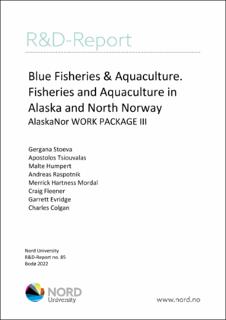| dc.description.abstract | In the Arctic, the sustainable blue economy is gaining ever increasing importance. This entails utilizing ocean-based resources to the benefit of the global population, the Arctic states and their local communities, while doing that in accordance with sustainability objectives. Obvious lessons concerning resource utilization and local adaptation are, however, not shared between Arctic regions. Limited coordination of knowledge when it comes to challenges and opportunities that arise as the blue potential unfolds should be further explored. This is what this report – as part of the AlaskaNor Project – sets out to do in the context of fisheries and aquaculture in the Arctic United States (Alaska) and North Norway.
This report is the end-product of Work Package (WP) 3, titled “Fisheries and Aquaculture”. With a focus on fisheries and aquaculture/mariculture management in both regions, this report aims at a) illustrating a comprehensive assessment of the status quo and challenges that these sectors face in both regions; b) drawing parallels among fisheries and aquaculture management; c) envisioning common goals and collaboration in the context of sustainable and blue governance structures.
In light of global anthropogenic issues such as climate change, and ongoing challenges that the world’s markets have been facing, it is imperative to realize that Arctic fisheries and aquaculture may provide a prominent arena for dialogue. Disregarding their geographical distance, Alaska and North Norway are both characterized by a strong dependence on marine living resources. In this report, we are addressing why fisheries and aquaculture/mariculture are important for the development of the blue economy in both Alaska and North Norway. Against this background the following three dimensions have been explored throughout this project: current status and governance, current and future challenges to development, and potentials for dialogue and collaboration. | en_US |

